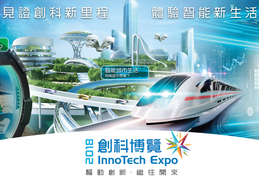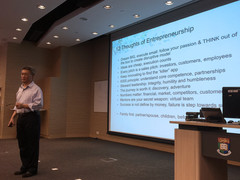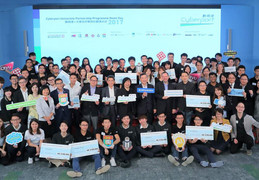HKU’s innovative research projects triumph at Special Edition 2022 Inventions Geneva Evaluation Days
29 Mar 2022
Back to NewsThe University of Hong Kong (HKU) garnered a total of 12 awards at the Special Edition 2022 Inventions Geneva Evaluation Days. Research teams from the Faculties of Architecture, Dentistry, Engineering and Science, and the Li Ka Shing Faculty of Medicine secured 4 Gold Medals, 7 Silver Medals and 1 Bronze Medal with their inventions in the event.
As one of the most prestigious innovation exhibitions, the International Exhibition of Inventions of Geneva (IEIG) is a remarkable annual global event which is devoted exclusively to inventions and innovations. This year’s competition was held in a virtual format in March 2022, where over 780 inventions from 25 countries and regions were evaluated by a panel of professional judges from around the world. The results were announced yesterday (March 28).
HKU has received a total of 41 awards including three prestigeous Gold Medals with Congratulations of the Jury and 15 other gold medals since its first participation in the event in 2018.
HKU’s award-winning inventions in 2022: -
Gold Medals
1. Fast-reconfigurable large-area interference lithography nanopatterning platform
This novel nanolithography technology is capable of reducing the processing time and cost of large-area nanopatterning by more than 10 times when compared with the best electron beam writers. It adopts fast-reconfigurable beam delivery, active phase stabilization, and computer-controlled automation, and enables high-throughput wafer-scale patterning of 1D and 2D nanostructures with feature sizes down to 40 nm. With the high efficiency and low cost in fabrication, the large-area periodic nanostructures patterned by this technology have great potential in the fields of AR displays, meta-optics, biomedical sensing, solar cells, and LEDs. This technology was developed by Dr. Wen-Di Li, Ph.D. student Mr. Zhuofei Gan, and other team members from the Department of Mechanical Engineering, Faculty of Engineering of HKU.
Video:
2. A customisable in-manhole sampling robot for sewage surveillance
Unlike the traditional bulky auto-sampling device, the customisable in-manhole sampling robot is small in size and can be installed inside a manhole, thus reducing the manpower involved and the impact on traffic during sewage data collection. After installation, the device will collect sewage samples automatically and allow customisable control for sampling activities and real-time feedback collection via Mobile App and Narrowband Internet of Things (NB-IoT). This device has been widely used in Hong Kong and has enabled the city-wide sewage surveillance to help control the COVID-19 pandemic. It was developed by Professor Tong Zhang and the team from Civil Engineering of HKU together with the Drainage Services Department and the Environmental Protection Department.
3. 3D Printed Reef Tile
Making use of robotic 3D printing technology and environmentally-friendly terracotta materials, the project creates suitable habitats for threatened corals using artificial reef tiles to enhance coral survivorship. This new method for artificial reef tiles will help to restore corals and conserve biodiversity more effectively, and become a vital contribution to the ongoing global efforts to save the degraded coral reef systems. It was developed by a research team led by Professor David Baker from the School of Biological Sciences, Faculty of Science of HKU. (Ref)
4. Light-Triggered Drug Delivery System
This system delivers drug molecules specifically to intraocular diseased sites and works in conjunction with green light for effective retinoblastoma therapy. This treatment strategy shows promise in a safer and more efficient treatment of retinoblastoma and other eye diseases due to its nature of avoiding conventional invasive intravitreal drug administration. It was developed by a research team led by Dr Weiping Wang from Dr Li Dak-Sum Research Centre and Department of Pharmacology and Pharmacy, LKS Faculty of Medicine, The University of Hong Kong. (Ref)
Silver Medals
1. Anti-Covid-19 stainless steel
This is the first anti-Covid-19 stainless steel with Cu-rich precipitates permanently present in the SS matrix with a long-term anti-Covid property, which can inactivate SARS-Cov-2 on stainless steel surfaces. This new invention not only help fight against the COVID-19 pandemic but can also replace some of the frequently touched stainless steel products in public areas, such as lift buttons and doorknobs, using existing powder metallurgy technologies for mass production. The invention was developed by Professor Mingxin Huang and Mr Litao Liu from the Department of Mechanical Engineering, Faculty of Engineering, and Dr Alex Wing Hong Chin, Research Assistant Professor and Professor Leo Lit Man Poon of the School of Public Health, Faculty of Medicine, of HKU. (Ref)
2. Disinfection Robot
This autonomous disinfection robot utilises a combination of automatic robot programming, autonomous navigation and obstacle avoidance, sensor-based robot control, and novel drives and structure to achieve effective disinfection within a short period. Its robot arm brings the UVC light close to the object’s surface while maintaining a proper distance to achieve 99.5% disinfection in just a few seconds, which allows fast disinfection of a large area. The user-friendly graphical user interface enables a user to select disinfection area based on video images and automatically generate robot trajectories to perform the disinfection operation. The invention was developed by Professor Ning Xi from the Department of Industrial and Manufacturing Systems Engineering, Faculty of Engineering of HKU. (Ref)
3. Method of purifying nanodiamonds (NDs) and application for oral hygiene
The Salt-Assisted Air Oxidation (SAAO) treatment is a purification method for nanodiamonds (NDs), and eliminates the unwanted parts of NDs to achieve a clean surface that is hardly accomplished by the conventional air oxidation approach. It has been proved that NDs after SAAO can work as an effective agent against the bacteria and fungi that are highly relevant in oral and systemic infections. SAAO was developed by Dr Zhiqin Chu, Assistant Professor and Tongtong Zhang from the Department of Electrical & Electronic Engineering, Faculty of Engineering of HKU. (Ref)
4. Micro Mist Scale mouthguard cleaning device
This is a novel 3D-printable multi micro-mist outlet mouthguard design for precise initial dental plaque removal for elderly or disabled people. The plaque cleaning apparatus uses a dental polymeric 3D printing technique combined with a personalised mouthguard, which can generate micro-scale mist precisely for the removal of initial dental plaque at the gumline and interdental areas. The minimal use of water during the process reduces the risk of aspiration, whilst the device enhances the user’s physical and psychological health and reduces the risk of Alzheimer’s, heart and kidney disease caused by oral bacteria. It was invented by Dr James Kit-hon Tsoi, Associate Professor and his team, from the Faculty of Dentistry, HKU. (Ref)
5. Non-contact, non-radiation device that accurately locates multiple implants in a patient's bodyA system with a handheld device consisting of contactless radiation-free mobile sensing technology precisely visualises the 3D location of orthopaedic surgical implants in a patient’s body. The 3D imaging model generated from the system, allows a prompt progress and condition update of the spinal instrumentation and provides timely warning of mechanical failure and faults in the implants to enhance surgery effectiveness and safety. It was developed by the research team of Dr Jason Pui Yin Cheung, Dr Teng Grace Zhang and Dr Weichen Qi from the Department of Orthopaedics & Traumatology, School of Clinical Medicine of HKU.
6. Nucleic Acid Aptamers for Malaria Diagnosis
This invention employs DNA aptamers that recognise two important malaria biomarkers and can be applied to clinical diagnosis of malaria through integration with a microfluidic system which can be observed with mobile devices. Being easily synthesised and manufactured, the aptamers can serve as an alternative to antibodies in a more robust and less expensive manner. It was developed by a research team led by Professor Julian A. Tanner from the School of Biomedical Sciences, Faculty of Medicine of HKU.
7. NevGro® - a Dietary Supplement for Brain Health
NevGro® is a dietary supplement for enhancing brain health and the compounds are extracted from Hericium erinaceus or the monkey head mushroom via an innovative aqueous extraction technique. The research team found that administration of NevGro® alleviated depressive-like symptoms through stimulating the growth of brain cells in the hippocampus, a brain region which is responsible for emotion, learning and memory. The study further revealed its neuroprotective effects against ataxia, by protecting the brain cells from degeneration in the cerebellum, which controls body coordination and motor function. This product is co-invented and developed by Ms. Cheng Poh Guat, CEO of Ganofarm R&D Private Limited, Dr. Wong Kah Hui from Universiti Malaya, as well as Dr. Lim Lee Wei and Chong Pit Shan from the Li Ka Shing Faculty of Medicine of HKU.
Bronze Medal
1. PD1-Based Vaccine for Infection and Cancer Cure by Potentiating Host Immunity
PD-1-based vaccine targets antigen to dendritic cells for enhanced antibody and CD8+ T cell responses. By developing a novel PD1-based active immunisation against viral infection and cancer under both prophylactic and therapeutic conditions, it provides prolonged cancer and viral infection control by potentiating host immunity. It was developed by the research team of Professor Chen Zhiwei, Dr Zhou Jingying, Dr Tan Zhiwu, Dr Wong Yik Chun, Professor Chen Honglin, Professor Yuen Kwok Yung and Dr Liu Li from the Department of Microbiology, Faculty of Medicine of HKU.
The participation was coordinated by the Technology Transfer Office of The University of Hong Kong (HKU).
For details about the International Exhibition of Inventions of Geneva, please visit: https://inventions-geneva.ch/en/home/.
About Technology Transfer Office, HKU
The Technology Transfer Office (TTO) manages the use of the intellectual property assets of the University of Hong Kong (HKU) by providing patenting, licensing and other commercialisation support to the University’s researchers. Acting as the bridge linking HKU to society in the area of technology commercialisation, TTO facilitates industries and businesses to access HKU’s powerhouse of knowledge, innovation and expertise through close collaboration. Website: http://www.tto.hku.hk.
For media enquiries, please contact:
Communications and Public Affairs Office, HKU
Ms Melanie Wan (Email: melwkwan@hku.hk)
Ms Rashida Suffiad (Email: rsuffiad@hku.hk)
Technology Transfer Office, HKU
Ms Joanne Cho (Tel: 2299 0177 / Email: joanne@tto.hku.hk)
E-Newsletter
Get the latest technology and news from us
If you do not wish to receive emails from us in the future, you can send an unsubscribe request to us by email to info@tto.hku.hk.





